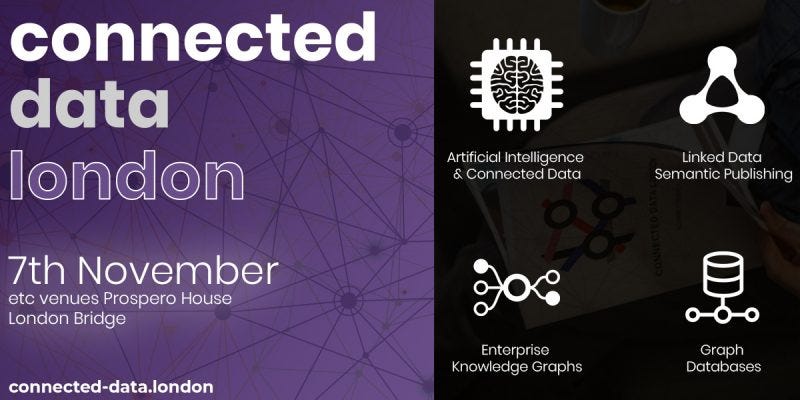Latest news about Bitcoin and all cryptocurrencies. Your daily crypto news habit.

Getting knowledge graph semantics and definitions right, semantic web standards used in the real world, by Google no less, and ArangoDB, Azure CosmosDB, Neo4j and TigerGraph announcing new versions.
By now you probably know that knowledge graphs are in Gartner’s Hype Cycle. But how does one actually define a knowledge graph? My take on ZDNet.
Knowledge graphs beyond the hype: Getting knowledge in and out of graphs and databases | ZDNet
And here is Stardog’s Kendall Clark’s take:
Alan Morrison from PwC on how Knowledge Graphs can help collapse the IT Stack
Did you know Airbnb also has a knowledge graph? You can read about it here. Note the insightful comment on the nuances of building knowledge graphs in the real world from LinkedIn’s manager of taxonomy
Scaling Knowledge Access and Retrieval at Airbnb
Want to know how knowledge graphs work in the real world? How to handle semantics at web scale, how this helps with data governance, how to evaluate graph databases, or how graphs and AI can work together? Then this is the event for you — check out the program officially announced:
Knowledge Graph and AI Experts for Connected Data London 2018 Program
Cruce Saunders from [A] elaborates on the relevance of the Semantic Web for enterprise publishers
What Is the Semantic Web and Why Should Enterprise Publishers Care?
Google just expanded search, so now you can also search for data. Besides being very useful, this also shows how schema.org and semantic web standards work in real life:
Google can now search for datasets. First research, then the world? | ZDNet
Dan Brickley, schema.org’s mastermind, on RDF and SPARQL
body[data-twttr-rendered="true"] {background-color: transparent;}.twitter-tweet {margin: auto !important;}
@namedgraph @TigerGraphDB RDF was designed as a data interchange framework; what you do in the privacy of your own database is your own business
— @danbri
function notifyResize(height) {height = height ? height : document.documentElement.offsetHeight; var resized = false; if (window.donkey && donkey.resize) {donkey.resize(height); resized = true;}if (parent && parent._resizeIframe) {var obj = {iframe: window.frameElement, height: height}; parent._resizeIframe(obj); resized = true;}if (window.location && window.location.hash === "#amp=1" && window.parent && window.parent.postMessage) {window.parent.postMessage({sentinel: "amp", type: "embed-size", height: height}, "*");}if (window.webkit && window.webkit.messageHandlers && window.webkit.messageHandlers.resize) {window.webkit.messageHandlers.resize.postMessage(height); resized = true;}return resized;}twttr.events.bind('rendered', function (event) {notifyResize();}); twttr.events.bind('resize', function (event) {notifyResize();});if (parent && parent._resizeIframe) {var maxWidth = parseInt(window.frameElement.getAttribute("width")); if ( 500 < maxWidth) {window.frameElement.setAttribute("width", "500");}}
Azure CosmosDB announced new capabilities at Microsoft Ignite 2018. None of those is graph-specific, but things like multi-master at global scale should come in handy regardless
Azure Cosmos DB - database for Intelligent Cloud - Intelligent Edge era
Neo4j also announced a new version, 3.5, at Graph Connect NYC. Main new features in v3.5, available in Q4 2018, are full-text search and new graph algorithm implementations.
A few days before Neo4j, TigerGraph also announced a new version. TigerGraph has added integration with popular databases and data storage systems, announced a github repository to host open source connectors, added support for graph algorithms, and a Neo4j migration kit.
Introducing the Latest Release of TigerGraph: Fastest Performance for Graph Analytics
ArangoDB has a new release in the works too: 3.4. A release candidate is available, and main new features are search, support for GeoJSON and Google S2 index, performance improvements via query profiling and streaming cursors, and making RocksDB the default storage engine
Release Candidate 1 ArangoDB 3.4 - What's new?
Wrapping up with some hands-on experience on working with graph databases, shared by Expero’s Josh Perryman
Would you like to receive the latest Year of the Graph Newsletter in your inbox each month? Easy — just signup below. Have some news you think should be featured in an upcoming newsletter? Easy too — drop me a line here.
Originally published at linkeddataorchestration.com on October 1, 2018.
The Year of the Graph Newsletter: October 2018 was originally published in Hacker Noon on Medium, where people are continuing the conversation by highlighting and responding to this story.
Disclaimer
The views and opinions expressed in this article are solely those of the authors and do not reflect the views of Bitcoin Insider. Every investment and trading move involves risk - this is especially true for cryptocurrencies given their volatility. We strongly advise our readers to conduct their own research when making a decision.
